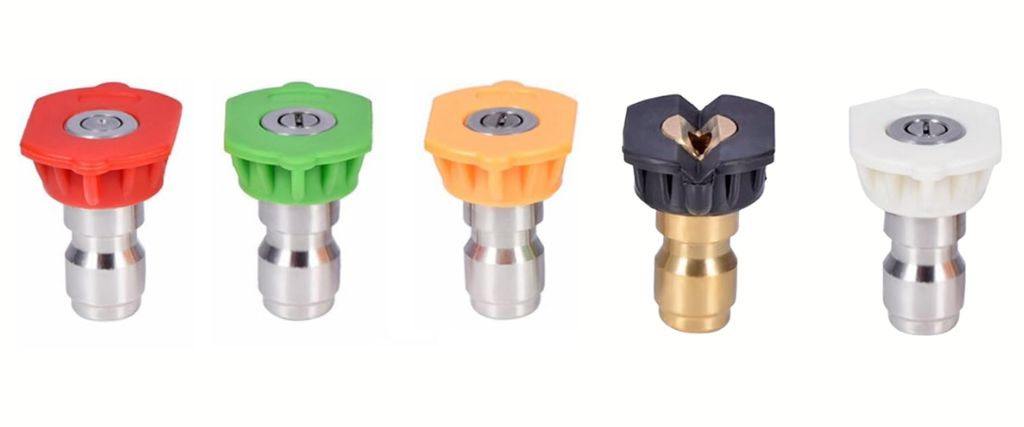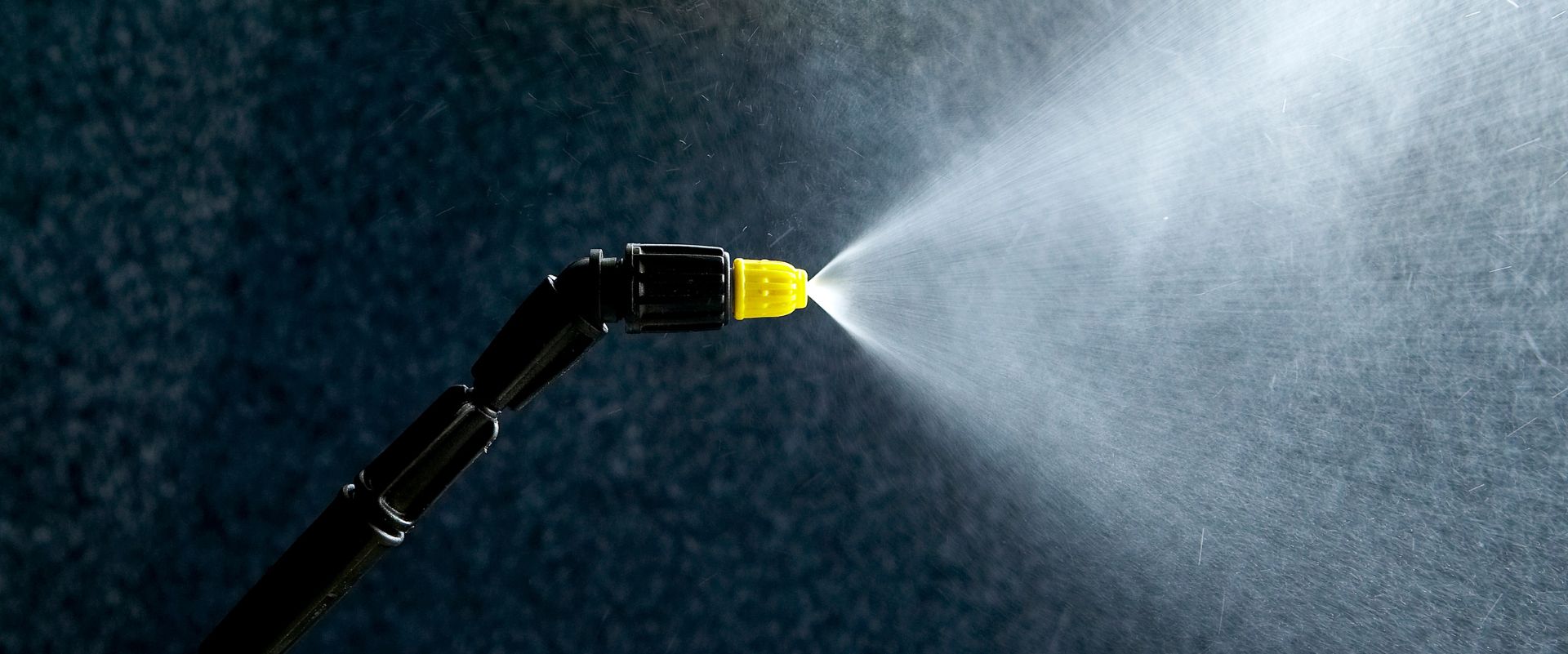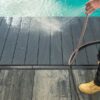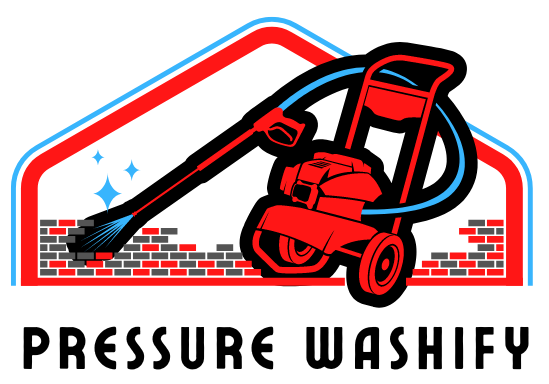Affiliate Disclaimer: This post may contain affiliate links, meaning we get a commission if you decide to make a purchase through our links, at no extra cost to you.
Pressure washing is a universal approach to cleaning that’s popular amongst homeowners and industrial spaces, thanks to the strength and versatility of the pressure washer. Although the machine itself is important, you’d be remiss not to pay particular attention to one small but essential component: the pressure washer nozzles.
A pressure washer, without the right nozzle, is akin to a race car with bad tires – it won’t perform at its best.
What Are Pressure Washer Nozzles?
Pressure washer nozzles are handy little components that may seem insignificant but hold considerable influence when it comes to dictating the intensity and angle of the water stream your pressure washer emits.
Connected to the tip of the pressure washer wand, these nozzles come in different shapes, sizes, and colors, each designated for specific duties based on their spray pattern and the degree of high-intensity pressure they let out. The variance in pressure and spray angle makes them suitable for different types of cleaning tasks.
Interestingly, without these nozzles, the water emitted from a pressure washer would come out all at once in an uncontrollable stream, which is ineffective for most cleaning tasks and potentially unsafe. These nozzles not just control the water flow but also significantly amplify the cleaning power of the water, making it far more effective in shifting stubborn dirt, grime, or unwelcome paint.
How Do Pressure Washer Nozzles Work?
The Principle Behind Pressure Washer Nozzles
- Pressure washer nozzles operate on a simple yet ingenious principle. Their main function is to refine a mass of water flow into a forceful, focused stream, suitable for carrying out various cleaning activities.
The Role of Nozzle’s Design
- The main trick lies in the design. The shape and size of the nozzle determine the pressure and spray pattern of the water jet. When you connect a nozzle to the pressure washer wand and start the washer, water surges into the equipment from your hose/pipe.
- This water is pressurized using a pump within the washer. On reaching the nozzle, the water is forced through a small opening which refines and focuses the water stream while accelerating it at the same time.
The Significance of Color in Pressure Washer Nozzles
- The color of the nozzles is not just for aesthetic value but actually symbolizes their functionality. Each color represents a different spray angle – the angle at which the water will leave the nozzle.
- For instance, a red nozzle has a zero-degree spray angle, making the running water come out straight, while a white nozzle has a forty-degree spray angle, hence it fans out the water.
The Impact of Pressure and Spray Pattern
- Both pressure and spray patterns determine how forceful the output will be and on what scale. This allows some nozzles to be better at large-scale rinsing and others at precise, powerful cleaning. Having interchangeable nozzles makes your pressure washer a versatile cleaning tool for a variety of tasks.
Different Types of Pressure Washer Nozzles
A fundamental understanding of the various types of pressure washer nozzles is essential to optimize the performance of your pressure washer. Each nozzle has its specific functionality and application. Below, we thoroughly explain the most common types:

Red Nozzle
The red nozzle, known for its zero-degree spray, produces a stream of water so concentrated that it resembles a pencil jet. This kind of spray is highly forceful and focused, making it perfect for tackling stubborn dirt or stains. Always exercise caution when using the red nozzle as its intense pressure can lead to damage if used incorrectly.
Yellow Nozzle
The yellow nozzle has a wider spray angle of 15 degrees. The result? A fan that’s still quite forceful but over a more substantial area. This makes the yellow nozzle superb for heavy-duty cleaning tasks such as removing dirt from concrete, decks, and other hard surfaces.
Green Nozzle
With a 25-degree spray angle, the green nozzle delivers a wider spray that balances between high-pressure cleaning and wider surface coverage. This fan is suitable for general cleaning tasks such as washing cars, boats, patio furniture, and more.
White Nozzle
Featuring a 40-degree spray angle, the white nozzle disperses water over an even larger area, making it ideal for gentle cleaning tasks. You can use it for light-duty cleaning such as washing windows, siding, or vehicles without worrying about causing damage.
Black Nozzle
The black nozzle stands out with its 65-degree spray angle and low pressure. It’s primarily used for spraying soap or detergents during the initial stage of the cleaning process.
The degree of the spray determines the angle at which water leaves the nozzle, affecting the intensity and breadth of the cleaning. A lower-degree nozzle like the red one results in a more intense but narrow stream, ideal for specific spot-cleaning. A higher-degree nozzle like the black one creates a gentler, wider stream, ideal for covering large areas or delicate surfaces. By understanding these differences, you can select the appropriate nozzle to ensure efficient and safe cleaning.
Our Recommendation
Check out the Twinkle Star Pressure Washer Nozzle Tips if you’re looking for a high-quality nozzle set (to replace the crappy default set that came with your pressure washer).
This set comes with multiple nozzle tips which can be selected based on your specific needs, improving the versatility and effectiveness of your pressure washer. Each nozzle operates at a different angle, allowing for targeted cleaning in hard-to-reach areas.
Ideal for users with a pressure washer rated up to 2.5 GPM, these 1/4-inch tips fit most pressure washers, making them an incredibly versatile addition to your toolkit. With the quality and diversity offered by the Twinkle Star set, you can clean patios, lawns, gardens, and more with efficiency and ease.
Special Purpose Pressure Washer Nozzles
Pressure Washer Turbo Nozzle
The turbo nozzle is a powerful pressure washer attachment designed to deliver highly concentrated jets of water, with a unique, spiraling pattern. This rapid spinning action allows the turbo nozzle to clean surfaces more quickly and effectively than traditional nozzles, making it perfect for tackling stubborn stains, grime, or dirt on hard surfaces such as driveways and concrete.
If you’re looking for a powerful and efficient turbo nozzle for your pressure washer, I highly recommend the Simpson Cleaning 80143 3600 PSI Universal Turbo Pressure Washer Nozzle.
This high-quality, universal nozzle features a 1/4-inch quick connect, making it compatible with most pressure washer systems.

Designed for both hot and cold water use, the Simpson Cleaning 80143 nozzle is capable of handling up to 3600 PSI, providing maximum cleaning efficiency. Its powerful spray pattern ensures the removal of stubborn dirt, stains, and grime from various surfaces.
Jetting Nozzle for Pressure Washer
Jetting nozzles are specifically designed for clearing clogs and blockages in pipes, drains, or sewers. With their sharp, concentrated jet of water, they can effectively break through and flush out accumulated debris, grease, or roots. This makes jetting nozzles an invaluable tool for plumbers and homeowners alike when dealing with difficult drainage issues.
If you’ve been searching for a high-quality, versatile jetting nozzle for your pressure washer, look no further than the PWACCS Sewer Jetter Nozzle Set.
This set includes three nozzles designed for different applications: Button Nose Jet Nozzle for sewer and drain cleaning, Rotating Flat Jetting Nozzle for broad coverage, and Drain Jet Hose Nozzle for standard cleaning jobs.

Each piece is made of robust and durable stainless steel and can handle pressure up to 5000 PSI, making them suitable for heavy-duty cleaning tasks.
The rotating flat nozzle is especially praised by customers for being extremely efficient in cleaning large surface areas. Whether you need to unblock drains, maintain your sewer lines, clean gutters, or power wash large areas, this set has got you covered.
Read our guide on unclogging a drain using a pressure washer for more information.
Adjustable Pressure Washer Nozzle
Adjustable pressure washer nozzles like the Meteor Blast Pressure Washer Nozzle offer enhanced versatility for a range of cleaning tasks. By simply twisting the nozzle head, operators can change the spray pattern and pressure to suit different surfaces and requirements.
Adjustable nozzles are ideal for cleaning sensitive materials that might be damaged by high pressure or large areas requiring wider coverage.
They provide greater control and flexibility while getting the job done efficiently.

Factors to Consider When Choosing a Pressure Washer Nozzle
Choosing the perfect pressure washer nozzle can make the difference between an effective cleaning process and a frustrating one. Here are some crucial factors you should consider when selecting a nozzle for your pressure washer:
Material
The material of the nozzle greatly influences its durability and lifespan. Nozzles made from high-grade stainless steel tend to last longer than those made from plastic or brass and can withstand more rigorous cleaning tasks.
However, plastic or brass nozzles might be easier on the wallet and sufficient for lighter, less frequent cleaning jobs.
Size
Nozzle size is a critical aspect as it determines the force of the water jet. Larger nozzles allow more water flow, resulting in a less forceful spray, while smaller nozzles restrict the water flow, creating a more powerful jet. Your choice should depend on the severity of the dirt or grime you aim to clean.
Spray Angle
As we’ve discussed earlier, the spray angle of the nozzle ranges from zero-degree to sixty-five-degree, signified by different colors. A zero-degree (red) nozzle delivers a powerful, narrow jet, while a sixty-five-degree (black) nozzle provides a gentle, broad spray. Choose according to the scope and intensity of your cleaning task.
Pressure Rating
The pressure rating of the nozzle should match the pressure of your washer. Using a nozzle with a lesser pressure rating than your washer can lead to damage. Always check the pressure rating mentioned on the nozzle before making a purchase.
Cost
Depending on the material and brand, the cost of pressure washer nozzles can vary significantly. Set a budget and consider your cleaning needs before deciding. Remember, investing a bit more can sometimes lead to better quality and durability.
Compatibility with the Pressure Washer
Lastly, it is crucial to ensure the nozzle you choose is compatible with your pressure washer model. Not all nozzles fit all washers, and using an incompatible one might not only hinder cleaning efficiency but could potentially harm your washer.
Tips for Using Pressure Washer Nozzles Safely
Using pressure washer nozzles effectively isn’t just about choosing the right one; it also involves adhering to certain safety precautions and best practices. Despite their immense utility, pressure washer nozzles can be hazardous if used incorrectly.
Below, we share some key tips for using these tools safely:
Safety Precautions and Best Practices
Use Protective Gear: Protect yourself with necessary safety equipment such as gloves, safety glasses, and sturdy footwear. The high-pressure spray can ricochet off surfaces and cause injury.
Inspect Equipment Before Use: Always check the washer and the nozzle for any damage or obstructions before you start. Using damaged equipment can be extremely dangerous.
Hold the Wand Securely: Pressure washers can have a substantial kickback due to the intense force of the water jet. Hold the washer wand securely with both hands to maintain control.
Stand on a Stable Surface: Make sure you are on a stable, non-slip surface when operating the washer to prevent falling over due to the washer’s recoil or slippery conditions.
Keep a Safe Distance: Always keep a safe distance from the surface you’re cleaning. The high-pressure output can damage surfaces or ricochet back toward you.

Dangers of Incorrect Use
Using pressure washer nozzles incorrectly can lead to several dangers:
Personal Injury: A pressure washer can exert a force strong enough to break the skin, leading to serious injuries. This is especially true when using zero-degree (red) nozzles that deliver a highly concentrated jet of water.
Damage to Surfaces: Incorrectly matching the nozzle to the task can damage the surfaces you’re trying to clean. For instance, using a zero-degree nozzle on a car can chip the paint or even dent the metal.
Damage to the Washer: Using the wrong nozzle or one that’s incompatible with your washer can lead to damage to the washer itself, reducing its efficiency and lifespan.
Regular Maintenance and Upkeep of Pressure Washer Nozzles
For your pressure washer nozzles to function optimally over time, regular cleaning and maintenance are key. Additionally, knowing when and why to replace your nozzles can be crucial in maintaining the overall effectiveness and longevity of your pressure washer. Here are some steps and tips to guide you:
Steps to Clean and Maintain Pressure Washer Nozzles
- Inspect Regularly: After each use, check your nozzles for any visible damages or obstructions in the spray patterns. Irregular spray patterns often indicate that the nozzle needs cleaning.
- Clean Appropriately: To clean a nozzle, first, try to flush out the obstruction by running water through the nozzle backward. If this doesn’t work, use a nozzle cleaning tool or a soft-bristle brush to gently dislodge the blockage.
- Store Properly: Always store your nozzles in a dry, clean place to avoid corrosion or damage. Consider keeping them in a case or a bag to prevent losing them.
- Handle with Care: Pressure washer nozzles, especially those made of plastic, can break or wear out if dropped or mishandled. Always handle and store them with care.
When and Why to Replace Nozzles
When to Replace:
Nozzles should generally be replaced when they start to wear out. Indicators of wear include a spray that’s losing its edge, irregular spray patterns despite cleaning, or a nozzle that’s visibly damaged or corroded.
Why to Replace:
Continuing to use worn-out nozzles can hinder your washer’s performance or even damage your pressure washer. Worn-out nozzles can increase the pressure in the pump, inducing unnecessary stress on the washer. Furthermore, keeping a fresh set of nozzles ensures optimum cleaning performance.
Frequently Asked Questions about Pressure Washer Nozzles
Q: Can I use any nozzle for every cleaning task?
A: Different nozzles are designed for different cleaning tasks. Using the wrong nozzle might result in either inefficient cleaning or damage to your surfaces. It’s important to choose the nozzle based on the cleaning pressure required and the area to be cleaned.
Q: What is the difference between a red and a green nozzle?
A: The main difference is the spray angle. Red nozzles produce a zero-degree spray angle that delivers a powerful, concentrated jet of water. The green nozzle, on the other hand, delivers a 25-degree spray angle, creating a wider fan, suitable for general cleaning tasks.
Q: How often should I replace my pressure washer nozzle?
A: It varies depending on usage and maintenance. However, if your nozzle exhibits inconsistent spray patterns despite cleaning, or if the spray is losing its edge, it’s probably time for a replacement.
Q: Can a pressure washer nozzle increase the pressure of my washer?
A: No, nozzles can’t increase the pressure of your washer. They merely direct the existing pressure in a specific manner. However, using a smaller or more concentrated nozzle can make the water jet feel more forceful.
Q: Can I use a pressure washer nozzle for my garden hose?
A: Regular garden hose is clearly not designed to handle the pressure from a pressure washer. Even though they may fit, using pressure washer nozzles on a garden hose can cause damage and is generally not recommended.
Q: Is it dangerous to use a pressure washer nozzle?
A: While the pressure washer itself is not dangerous, the high-pressure water it produces can be. It’s crucial to follow safety precautions, such as wearing protective gear and controlling backflips, to avoid accidents and injuries.
Q: What type of nozzle should I use to clean my car?
A: For car cleaning, a white (40-degree) or green (25-degree) nozzle would be ideal. They provide a gentle yet effective clean without damaging the vehicle’s paintwork.
Q: Is a zero-degree (red) nozzle safe for all surfaces?
A: No, due to its powerful and concentrated jet, a zero-degree nozzle can damage delicate surfaces or even carve into harder materials. It should be used cautiously and only for specific, stubborn dirt or stains.









